Log Cabin Vintage Blog
My Top Five Tips to Decorate with Blue Books After the Holidays
January is here, the holidays are over, and you probably have begun putting away (or already have put away) all the decor that has brightened your home for the last month or so. It can feel a little blah around the house with the bright & shiny decor tucked away for another season. The dreary weather of January does not help either. But there's hope - we can breathe new life into our homes this winter season! Today I am sharing my top five tips to bring personality & some color to your winter decor - all with the help of just a few books - blue books to be exact.
WHY BLUE BOOKS?
Blue is the perfect color to help transition from Christmas to the winter months. Blue still lends a bit of that holiday feel we may not be ready to let go of just yet. Blue is also known for its calming effect – perfect for recovering from the hustle & bustle of the holidays. And blue has long been associated with January (okay not always in a good light - think the winter blues). But why can't we change the narrative & instead of looking at the winter blues as a bad thing, embrace it & look at it as a good thing. A new look, fresh start, etc. I mean that is what The New Year is all about anyway, am I right?
MY TOP FIVE TIPS
1. Extend the holiday feel just a bit longer. Keep one or two of your favorite Christmas decorations out & display them with some books. Last year, I was gifted these antique Christmas balls with log cabins on them & they quickly became one of my favorite decorations (yes, I really do live in a log cabin). I hate putting them away when we take down the tree, so this year I decided to pair them with a blue book stack. It allows me to enjoy them for another season before being packed away until next December. What are your favorite holiday decorations & how can you incorporate them into a vignette or two for January?
2. Let your home decor tell a story. Add warmth & character to your home by combining vintage books with personal photographs. Pair favorite books from your parent's childhood with a beloved photo of them or favorite books from your childhood with a photo of you from childhood. This simple display not only brings a splash of color into your decor but also invokes a sense of nostalgia that’s sure to brighten up any room. It's a subtle yet meaningful way to honor the past while adding a personal touch to your space. I paired a small collection of Hardy Boys books with a photo of my dad & his sister sitting on a sled, in the snow, outside of their childhood home. Hardy Boys were a favorite of my dad's growing up - each week he borrowed a different edition from the library to read - so this fun vignette is a nod to my dad's childhood.
And the best news is, this vignette can easily be updated as the seasons change. Simply change the photo on display or the color of the book stack. My next photo to be displayed in this vignette is one of my grandparents in their motorboat on Lake Wallenpaupack (in the heart of the Poconos of Pennsylvania) with my dad’s german shepherd, Lady – man did that dog love riding around the lake in the boat. I love displaying these old photos around our home as little nods to our family history. What old, family photos have you been meaning to display?
3. Use color in your décor to set a mood. When it comes to color, blue is universally known for its calming, peaceful effects. Adding blue books to your post-holiday decor can instantly bring a sense of tranquility to your space, especially after the often-chaotic days of the holidays. The soft, cool tones of blue can evoke feelings of relaxation, making it an ideal choice for spaces like the living room or bedroom. Consider creating a stack of vintage blue books on a coffee table or display them on a shelf to add a soothing touch to your surroundings.
Here, Mary Pat of @the.beautiful.everyday added this beautiful edition of The Hobbit by J.R.R. Tolkien along with other books to her mantel where she displayed a few favorite pieces. The choice of colors & objects in her styling gives off peaceful, beach vibes.

You can also go in the opposite direction & intentionally add books to give a space a bold pop of color. This is yet another great way to let your personality shine in your décor. Melissa @1879books used a collection of Junior Deluxe Editions to add a pop of color in her guest bedroom & I love the result. It is unexpected to have children's books in bright colors in a space decorated with muted colors. The unexpected contrast is a brilliant use of color. Your eye is immediately drawn to the books (and if you are anything like me, you immediately want to zoom in to read the titles of each volume). What mood do you want to create in your living spaces?

4. Have fun with your décor: Add a bit of Whimsy. I have had this artist's moveable mannequin for quite some time, and it was fun to use it on a bookshelf inside a glass front cabinet in such an unexpected way. It adds just the right amount of whimsy to my collection of non-fiction books, so they don’t seem too stuffy (and yes, the books shown are a few of my childhood favorites and all fiction). How can you add a little (or a lot of) whimsy to your spaces?
5. Don’t let your book covers have all the fun: Embrace the Beauty Inside Your Books. Open up those books & let those pages take center stage! Whether you're displaying images from your favorite illustrator, vibrant color plates, or a favorite passage, the interior of a book can provide a beautiful & meaningful addition to your space. Joette @sassafraslanestudio, an artist herself, used a vintage book stand from her husband’s hometown to display floral illustrations within the pages of a vintage botanical book to bring a bit of calm color & the warmth of summer into her home as she transitions from the post-holiday season. Using this book filled with illustrations allows her to change the look and color of this space with just the turn of a page. I love how she added the book stand & open book to add even more interest to this corner of her living room, all while honoring pieces that have meaning to her family. What’s a favorite illustration or book quote you can display?

NEW WEBSITE COLLECTION
So, what is your favorite way to add a bit of post-holiday cheer to your home? Leave a comment below & share your favorite tips & tricks. Are you ready to fill your home with books that help you express your personality & help you fight the winter blues?
It you’re ready, Log Cabin Vintage is here to help! And to make it easier than ever, I just added a Shop by Color drop down to the top me menu bar of the website. You can now shop books by color, including blue books. Make this the year you create a deeper emotional connection with your decor by bringing in those books that you loved as a child. The ones that bring back so many wonderful memories of the hours spent reading these precious stories over & over again. Filling your home with cherished books makes your space unique & a reflection of who you are. And most importantly, it helps chase away those winter blues. Shop now.
Here’s to a year of displaying our favorite books in creative ways around our homes. Using what we love to surround ourselves with pieces that showcase our personality.
Happy decorating & reading,
Wendy
What is Jólabókaflóð & Why We Should Adopt This Tradition Too!

Did you know that Christmas Eve in Iceland is called the Jólabókaflóð or Book Flood?
You see, folktales have deep roots in Icelandic traditional storytelling & so books have always played an important role in Icelandic culture. In other words, the people of Iceland love books and love to read! Apparently, some Icelanders joke storytelling is a national pastime.
WHAT IS JOLABOKAFLOD?
Jólabókaflóð is the tradition of gifting books on Christmas Eve and then spending the remainder of the evening reading the gifted books along with drinking hot chocolate and eating sweet treats! Now that is a tradition I can get behind! - who's with me?!
The tradition began during World War II when the nation was new & almost everything except paper was rationed. It has continued to this day. Iceland also publishes more books per capita than any other country.*
So, it comes as no surprise they have embraced this wonderful tradition. And what a lovely tradition it is, simple yet beautiful. There is nothing better than receiving books - pair it with sweets & hot chocolate & it makes a wonderful way to spend an evening.
START YOUR OWN TRADITION
Busy on Christmas Eve? Schedule your own Jólabókaflóð during the holidays or in the beginning of January. Why not start a new tradition in the New Year - wouldn't this be a great activity to plan for January when the post-Holiday Blues set in? Gather a few close friends, exchange books (you know the website is filled with wonderful books including a collection of Folk Tales), serve up some hot chocolate along with a batch of these Oatmeal Fudge bars & enjoy a wonderful evening (or afternoon) of book reading & friendship.

And if spending an evening reading books isn't enticement enough to start a new tradition, how about a recipe for Oatmeal Fudge Bars you can make & share during the evening? This wonderful, sweet treat comes from my mom, who has been making it for as long as I can remember! It is a family favorite - among both our immediate and extended family. I love this recipe so much; my mom often makes it for my birthday each year & at Christmas as well. This recipe makes a 15 1/2 x 10 1/2 jelly roll pan so I like to cut it into thirds & freeze two of the three portions to enjoy later. I have been known to hide the frozen portions so I don't have to share it - please don't judge me, it's just that they are that good, you will want to keep them all for yourself!
*Some information taken from goodnet.org
Small Business, Big Heart: A Holiday Gift Guide

Join us in spreading joy this holiday season while celebrating the artistry & passion of women creators/business owners. Our carefully curated guide features a delightful selection of women-owned businesses, each offering unique and thoughtful treasures that are perfect for everyone on your list.

Nurturing Curiosity: Homeschool Curriculums Made with Heart
Prairie & Pine Curriculums is a thoughtfully designed homeschool curriculum designed by two former public educators that brings literature to life through engaging, theme-based unit studies. Their approach emphasizes critical thinking, creativity, and real-world connections, offering families a meaningful way to explore classic and contemporary works. With options for all grade levels, Prairie & Pine inspires a love of learning and storytelling in every home classroom.
My Gift Pick: Understood Betsy Unit Study
For families cherishing classic literature and meaningful educational experiences, the Understood Betsy Unit Study - A Change of Pace is an exceptional gift. Inspired by Dorothy Canfield Fisher’s timeless novel, Understood Betsy, this curriculum offers a unique literature-based approach designed for elementary students. It engages children with thought-provoking activities that promote critical thinking, reading comprehension, and writing skills, all while building a deeper connection to this heartwarming story of resilience and growth.

Shop with Purpose: Fair Trade Seasonal Gifts & Decor
For those searching for the perfect seasonal gifts that capture the magic of the holidays, Welljourn presents the Christmas Favorites Ornaments Collection. This woman-owned business specializes in creating enchanting and timeless holiday decor that adds a touch of whimsy and joy to every celebration. The shop is filled with fair-trade, artisan-made items from around the world.
My Gift Picks: Bird Ornaments
Transform your holiday festivities with these adorable bird ornaments. Each piece is a work of art, handcrafted with attention to detail and a commitment to infusing the season with charm. From classic and elegant to whimsically delightful, these ornaments are designed to become cherished keepsakes, bringing a touch of joy to your holiday traditions.

Art That Inspires: One-of-a-Kind Pieces and Workshops
Tyree Dworak Art has drawn inspiration for her work from the world around her throughout her career as a visual artist. From painting bucolic farm scenes and animals to sculpting woodland creatures, she has made a large variety of things over the years. Practicing with such a variety of media has given Tyree a strong foundation for the work she now creates. In the last few years, she has found a home with ceramic sculpture. Tyree creates figures in clay and has cultivated her own style of slip application to create texture while using her painting background for a variety of surface treatments. Tyree deftly combines skills and materials across mediums to create stories with her whimsical sculptures. Inspiration might spark from a found object or some personal tale. Regardless, the feelings Tyree portrays are universal: humor, joy, curiosity, loneliness, love. Tyree’s work invokes a feeling of kinship in her viewers: they are part of her world and she is a part of theirs. Visit her account here to explore the pieces currently for sale.
My Gift Picks: Give the Gift of an In Person Class
What better gift than the gift of learning? Tyree offers several in person classes throughout the year including an upcoming ten-week study of the human head starting early next year. This sculpture class explores the study of the human head & is tailored to enrich beginners and experienced artists alike.

Give The Gift of Nostalgia This Holiday Season
Imagine a bookshop filled with your favorite books from childhood all in one place. That is exactly what Wendy envisioned when she created Log Cabin Vintage. This vintage bookshop is filled with books from our childhoods - from favorite Fairy Tales to the Classics we loved reading for the very first time, there is something for everyone. Did you solve mysteries right alongside Nancy Drew & The Hardy Boys, cry when Jack died while reading the Little House on the Prairie series, rejoice when The Little House was finally moved out of the city back to the country where she belonged? Does the mere mention of these titles bring back wonderful childhood memories? Then this is the shop for you.
My Gift Picks: Classic Children's Literature
This holiday season give the gift of nostalgia with a vintage children's book for those on your list. Here are a few unique takes on what books to choose – a book published the year the recipient was born, a book from their favorite genre, a favorite book from childhood...with a variety of collections to choose from, you are sure to find the perfect gift for each person on your list this this season.
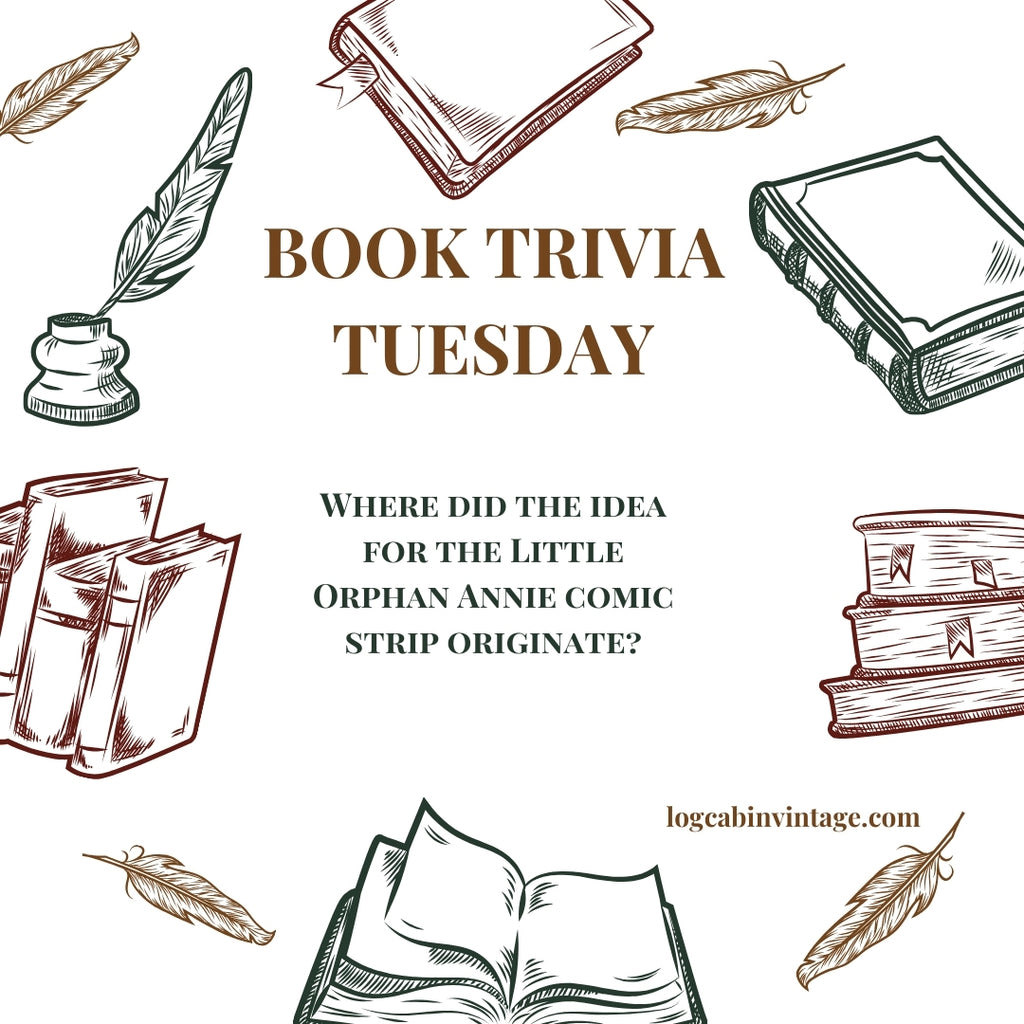
Book Trivia Tuesday - Week 17
Hello and welcome to another week of Book Trivia Tuesday. Last week we discussed Maurice Sendak's second career as a costume designer for plays & musicals.
This week we are focusing on someone who was once known as America's most loved poet. Perfect as we celebrate Poetry Month.
Where did the idea for the Little Orphan Annie comic strip originate?
Harold Gray, who created the Little Orphan Annie comic strip in 1924, used James Whitcomb Riley's poem, Little Orphant Annie, which Riley wrote in 1885, as the basis for the comic strip. And as we know, the comic strip has led to movies, plays and more based around our beloved Little Orphan Annie.
James Whitcomb Riley was born in Indiana in 1849 and after quitting school at age 20 & working a few odd jobs, his longest being a sign painter, took his poetry writing full time. He wrote poems & went on tour reciting them at local theaters throughout the country. We can thank Henry Wadsworth Longfellow for encouraging Riley to quit his job as a sign painter to pursue writing poetry.
And while he is no longer as popular as he once was, his legacy lives on in the Indiana Public Library for which he donated the land. After his passing, friends of Riley established a memorial association which then created the James Whitcomb Riley Hospital for Children and a camp for children with disabilities named Camp Riley.
He is also known as The Hoosier Poet & The Children's Poet.
To purchase his works, visit the James Whitcomb Riley Collection.
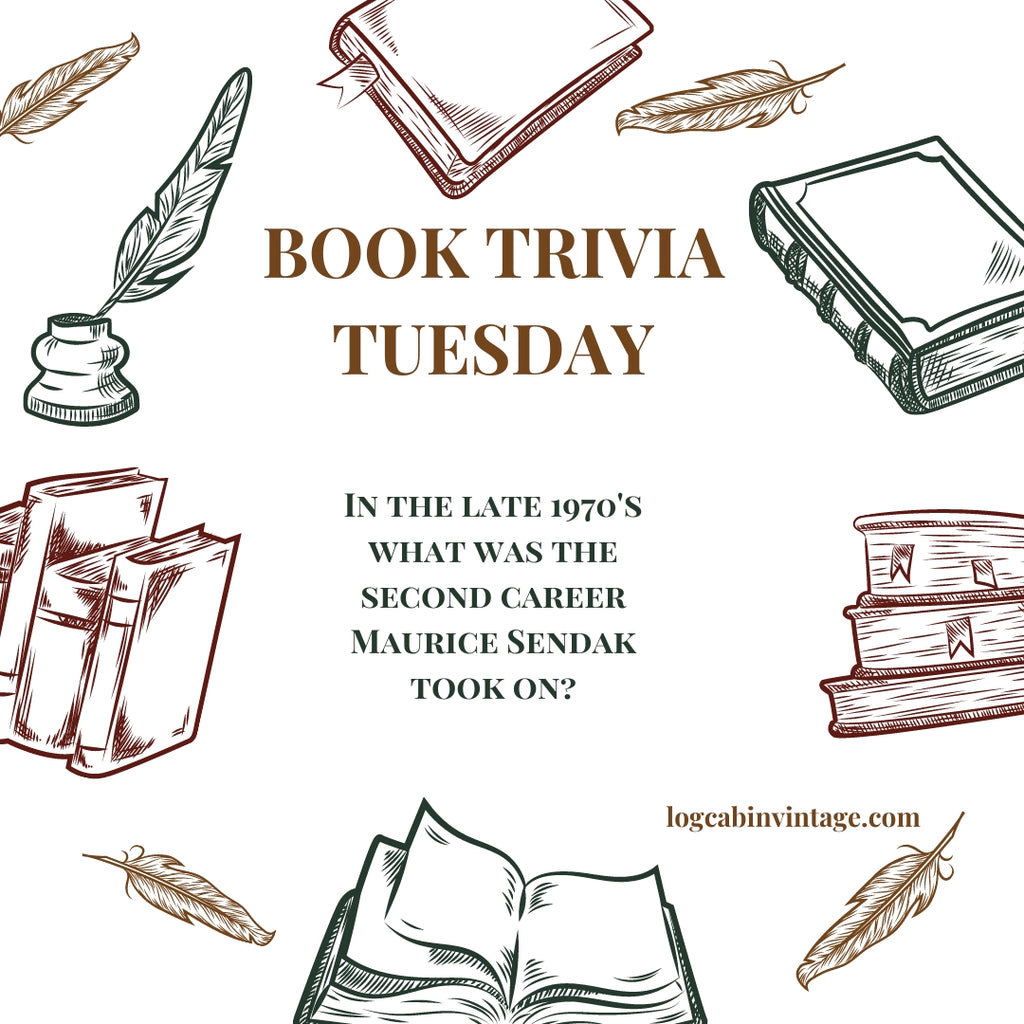
Book Trivia Tuesday - Week 16
Good morning & welcome to this week's Book Trivia Tuesday! Two weeks ago, we discussed some of the names pitched for the Nancy Drew Mystery series by Edward Stratemayer before the name Nancy Drew was settled on.
This week we are shifting gears & focusing on Maurice Sendak. Not only did Sendak write & illustrate his own children's books, but he also illustrated books for other authors as well, most notably The Little Bear books written by Else Holmelund Minarik. But did you know he had another job, which leads to this week's trivia question: In the late 1970's what was the second career Maurice Sendak took on?
Sendak became a costume designer for opera and musical sets in the late 1970's, working on such operas as Krása’s Brundibar, Mozart’s The Magic Flute, Prokofiev’s The Love for Three Oranges, and Engelbert Humperdinck’s Hansel and Gretel, as well as Tchaikovsky’s ballet, The Nutcracker. He also designed the sets and costumes, as well as wrote the book and lyrics for the musical production of Really Rosie. - Taken from his official website shown below.
Let's dig a little deeper into his life: Although his most famous work is Where the Wild Things Are, he wrote and illustrated 15 books. He also worked with six authors to illustrate their books & illustrated many classics including Mother Goose and The Brother Grimm Fairy Tales.
"Maurice Sendak remains the most honored children’s book artist in history. He was the recipient of the 1964 Caldecott Medal, the 1970 Hans Christian Andersen Award, the 1983 Laura Ingalls Wilder Award, and the 2003 Astrid Lindgren Memorial Award. In 1996 President Bill Clinton presented him with the National Medal of Arts in recognition of his contribution to the arts in America". ~Taken from the Biography page of The Maurice Sendak Foundation's website.
You can see some of his works at the following two exhibits this year:
Skirball Cultural Center
April 17, 2024 thru September 1, 2024
Denver Art Museum
October 13, 2024 thru February 17, 2025
And lastly, you can download resources for learning & teaching more about his books on his website: www.mauricesendak.com
To find Sendak's books currently available for purchase here at Log Cabin Vintage, click here.
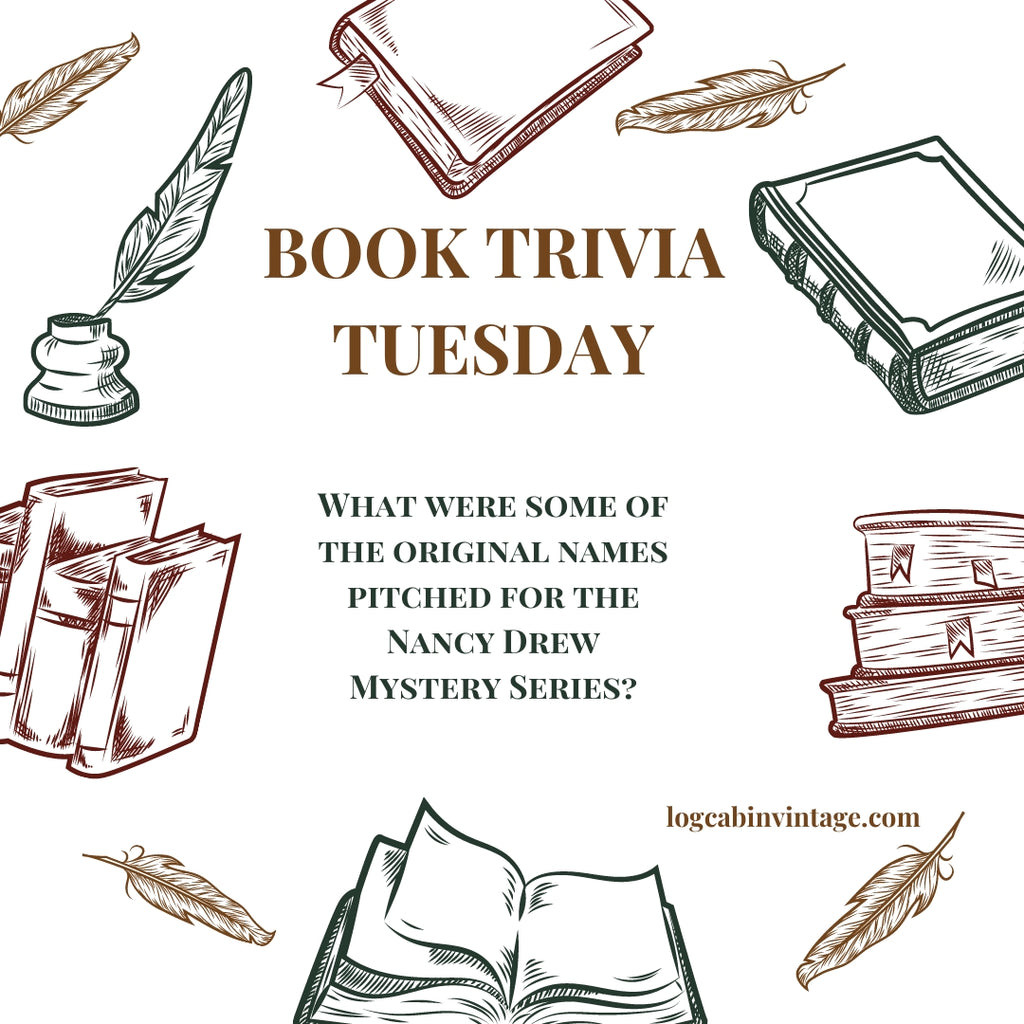
Book Trivia Tuesday Week 15
Welcome to another week of Book Trivia Tuesday. Last week we discussed Beatrix Potter's first name - Helen.
This week we are back with another fun piece of trivia: What were some of the original names pitched for the Nancy Drew Mystery Series?
While Edward Stratemayer was pitching the concept of a new mystery series to his publishers, names like Diana Dare, Nan Drew, Helen Hale and Stella Strong were all suggested. Publishers settled on Nan Drew but decided to lengthen it to Nancy because they felt it rolled off the tongue more easily.
And while we are at it, let's talk about a few other little-known facts about Nancy Drew:
- Carolyn Keene was not a real person, but a pseudonym used by a group of writers throughout the lifetime of the series.
- Edward Stratemayer wrote the outlines for each book but hired writers to write the actual stories. Mildred Wirt penned 23 of the first 25 books in the series.
- When people refer to Carolyn Keene's birthday, they are using Mildred Wirt's birthday as the date.
- The Nancy Drew books have inspired so many women over the years with its strong female main character, but did you know Stratemayer thought women belonged in the home? He only created the series after the success of The Hardy Boys Mysteries & wanted to duplicate that same success with a female lead.
- No illustrator is named in any of the Nancy Drew books; however, Russell Tandy created the dust jacket illustrations along with the content illustrations for the first 25 books of the series.
- Did you know the books were modernized throughout the years to stay relevant to each generation of readers? The original Nancy Drew books were written in the 1930's, long before the Mustang was ever produced by Ford. Yet in the books of the 1970's, Nancy owns & drives a Mustang. In the original books, her car is referred to as a blue roadster.
There is so much fascinating information out there on the history of the Nancy Drew books. What little tidbit of information do you have about the Nancy Drew series?
Find a selection of Nancy Drew Books for sale here.
**Some information from this post was taken from 10 Surprising Facts About Nancy Drew written by Stacy Conradt on March 11, 2019, for the website Mental Floss.
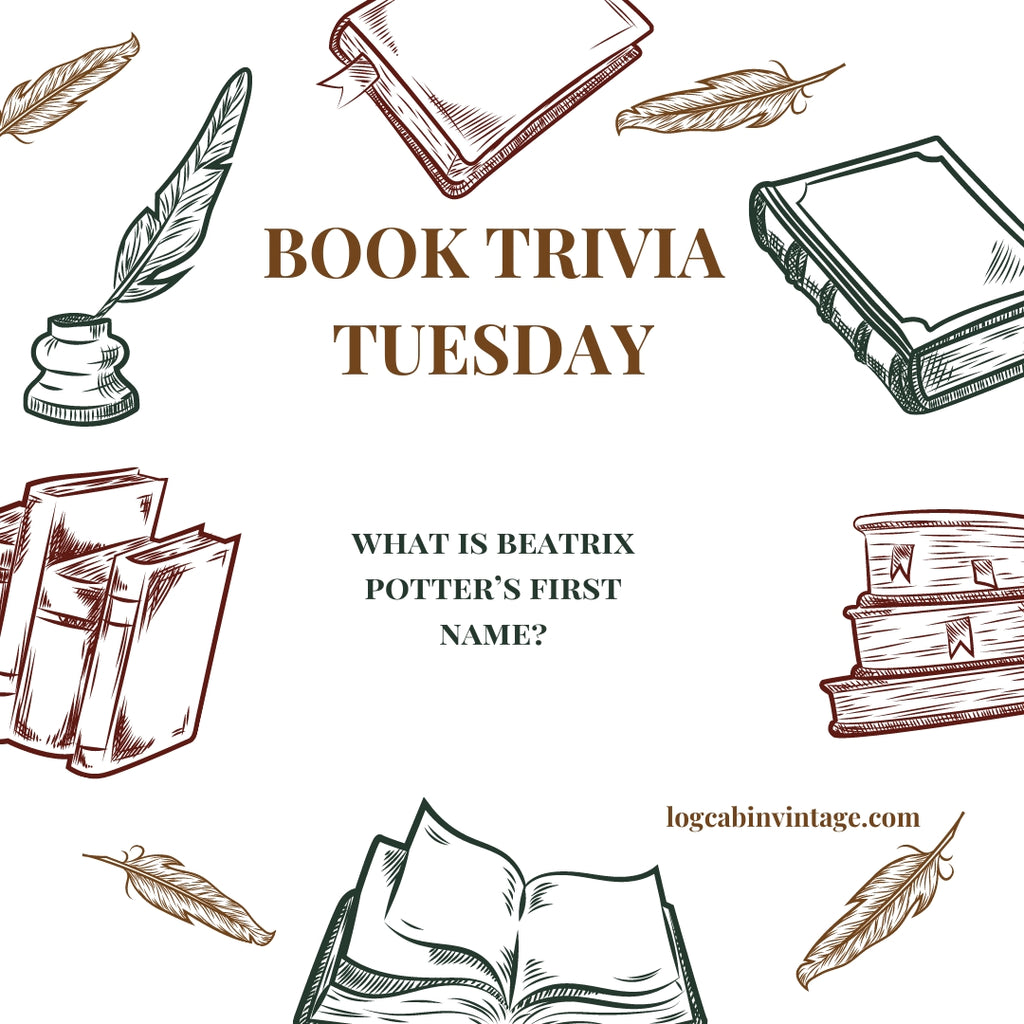
Book Trivia Tuesday Week 14
Welcome to this week's edition of Book Trivia Tuesday! Last week we had a little fun with Dr. Suess & his pen names.
This week we welcome the return of Spring! And, as you may know, March is Women's History Month! Over on social media, I have been sharing information about different woman authors & illustrators who have impacted the literary world. I chose this question about Beatrix Potter because she not only impacted the literary world with the sweet books we have all grown up reading, but because she was also a natural scientist & conservationist. Perfect to feature for Women's History Month & to help us Welcome Spring!
This week's question is this: What is Beatrix Potter's First Name?
Born in England in 1866 she was named Helen Beatrix Potter. She is best known for her beloved Peter Rabbit books which have sold over two hundred and fifty million copies. Along with her brother, Bertrum, they had a rotating collection of animals they would sneak into their home during childhood including rabbits she named Benjamin & Peter. In 1893, she wrote a letter to Noel Moore (the son of her one-time governess) and since she had nothing to say to him, told him the story of four bunnies: Flopsy, Mopsy, Cottontail and Peter, with which she included an illustration of Peter looking like he was ready for mischief.
But did you also know she was also a natural scientist and conservationist? When she was in her late 40's she left her parent's home in London & bought a cottage in a remote English countryside. There she raised prize-winning sheep and became a farmer. She bought the 34-acre farm after the sudden death of her fiancé, Norman Warne, who also happened to be her publisher. "In Potter’s grief, she set about planting a garden. Years later, she wrote of the house, “It is in here I go to be quiet and still with myself. This is me, the deepest me, the part one has to be alone with." In the eight years after Warne's death, she wrote twelve books. When she died in 1943, she left more than four thousand acres, and many working farms, to the National Trust, which now owns more than twenty per cent of the Lake District. Her bequest remains the Trust’s largest acquisition in the area.
Information was taken from an article by The New Yorker entitled The Secret Life of Beatrix Potter dated March 12, 2022, which can be found here.
To find a collection of her books click here: https://www.logcabinvintage.com/collections/beatrix-potter
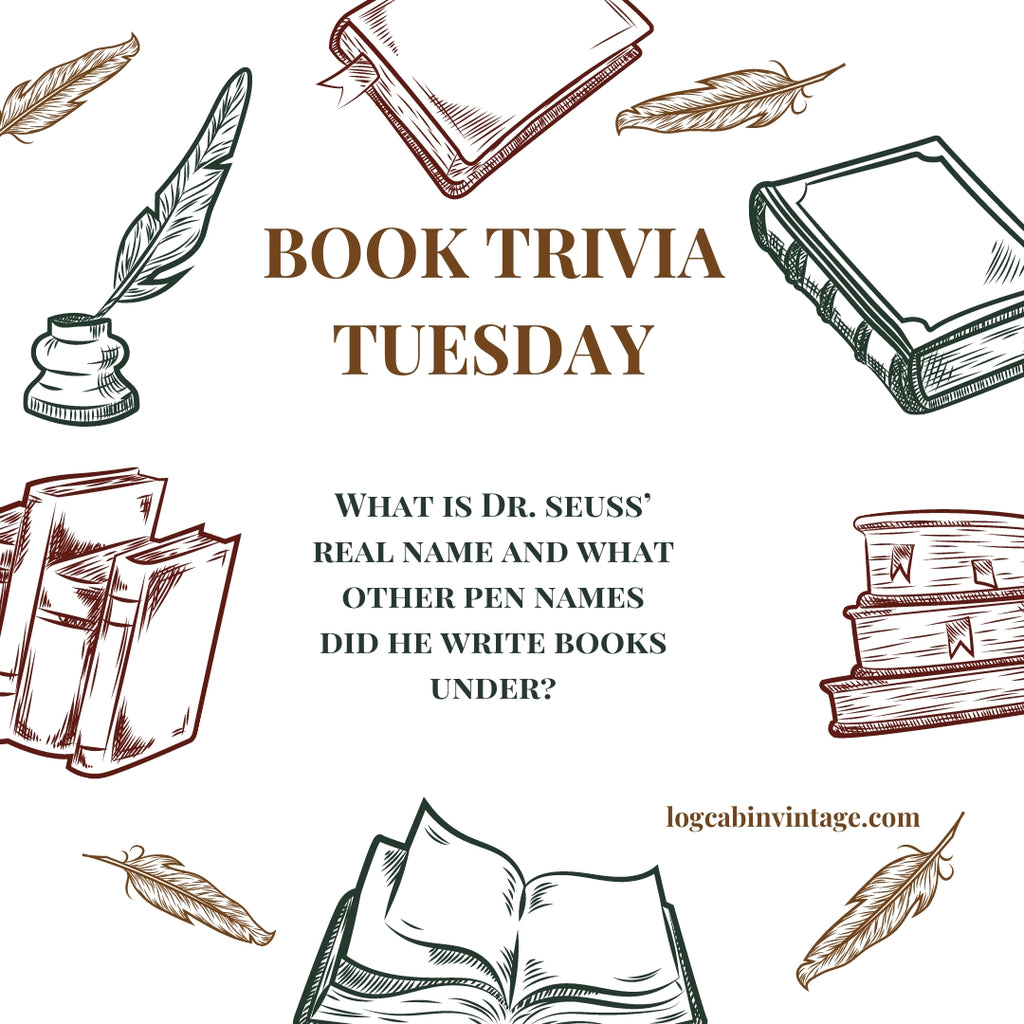
Book Trivia Tuesday Week 13
Two weeks ago, we discussed illustrator, John Schoenherr, the1988 Caldecott Medal Winner.
This month we are going to celebrate a pioneer in making reading fun for kids: Dr. Seuss. Today's Dr. Suess Trivia Question is: What is Dr. Seuss’ real name and what other pen names did he write books under?
Theodor Seuss Geisel was born on March 2, 1904, in Springfield, MA. During his writing career he wrote under the names Theo LeSieg, Rosetta Stone, and of course his most famous name, Dr. Seuss. He founded Beginner Books, Inc. in 1958 (which became a division of Random House in 1960).
During his career, he wrote more than 60 books, served in the Army during World War II and he won a Pulitzer Prize in 1984. Read Across America is celebrated on his Birthday every year in his honor.
What Dr. Seuss books did you read as a child & which one has stuck with you all these years?
Find a collection of his books here.
To find a collection of books published by Beginner Books, Inc., click here.
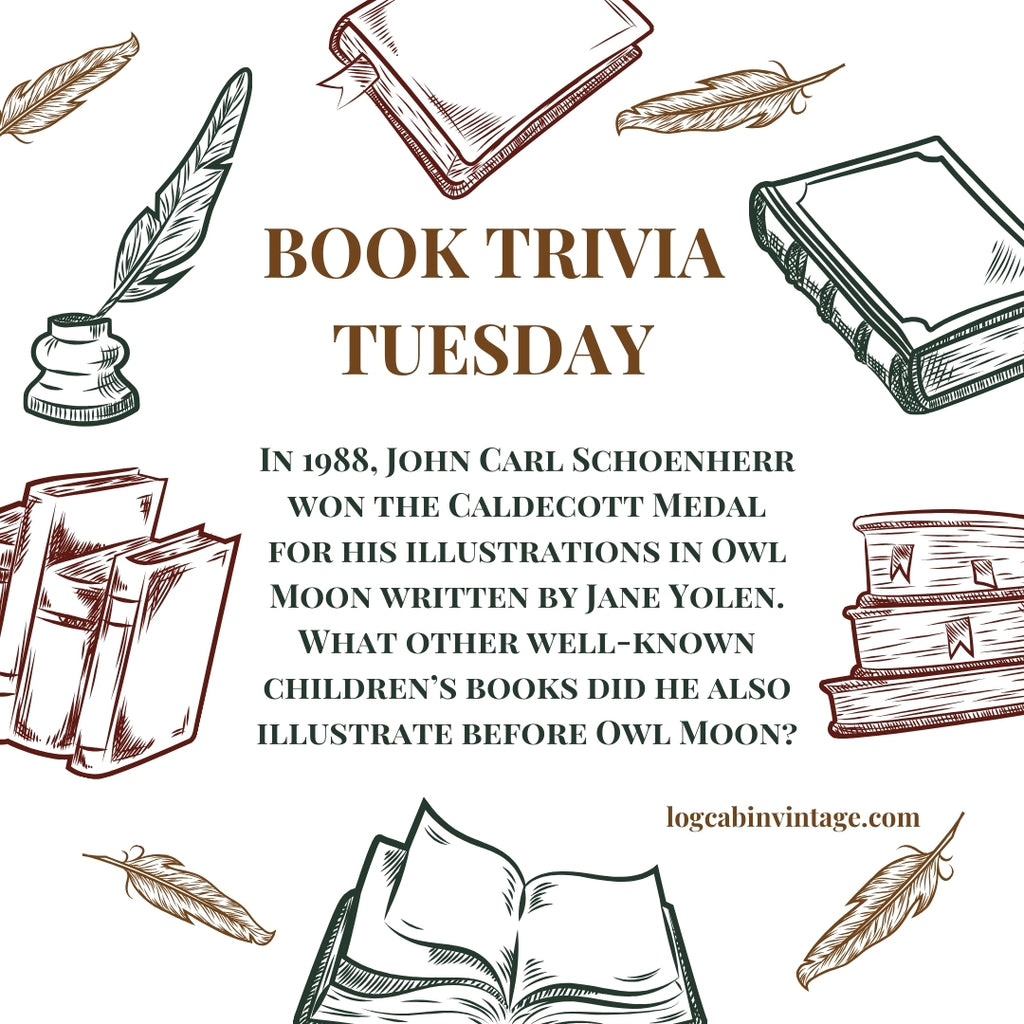
Book Trivia Tuesday Week 12
Last week we discussed the origins of Mother Goose & the long tradition of stories handed down by word of mouth.
This week's question comes after a visit to The Brandwine Museum of Art last week with my bestie. We went to see the exhibit on Children's Book Illustrators titled Rooted: Family and Nature in Contemporary Children's Book Illustration. What a wonderful exhibit. We both came home with a few books from the exhibit & learned so much. Not only did we get to see some amazing artwork in the exhibit, but we also learned so much more about other artwork including many local artists. I will be sharing another blog post about my favorite pieces from the exhibits soon.
But now onto today's trivia question: John Schoenherr won a Caldecott Medal for his illustration of the book Owl Moon (written by Jane Yolen) in 1988. What other well-known children's books did he also illustrate?
Born on July 5, 1935, John Schoenherr was a graduate of Pratt Institute in Brooklyn, NY. After he married, his family settled in New Jersey in a farmhouse where he rekindled his love of nature. During his career, he illustrated over 40 books. Famous books he illustrated include Gentle Ben written by Walt Morey, Julie & the Wolves written by Jean Craighead George, and Rascal, written by Sterling North. He also illustrated a number of Science Fiction book covers including Dune written by Frank Herbert.
In the years leading up to illustrating Owl Moon, Schoenherr primarily painted and was featured in galleries across the country. When he read Owl Moon, it reminded him of his nighttime walks with his own children and he used their family farm as the setting for the illustrations found in the book. It was a good choice as it earned the book a Caldecott Medal in 1988.
Do you have a favorite book he illustrated? I loved the Julie of the Wolves books so I would have to go with them as my top choice.
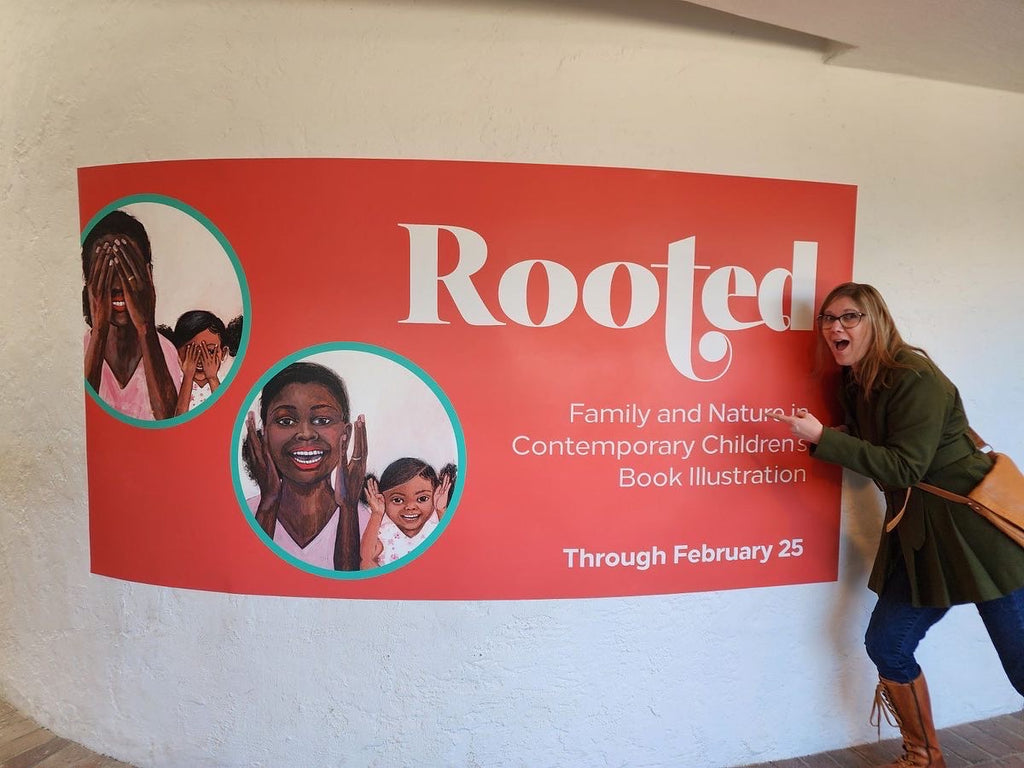
A Trip to the Brandywine Museum of Art to view the exhibit: Rooted: Family & Nature in Contemporary Children's Book Illustrations
On Monday my bestie & I visited the Brandywine Museum of Art in Chadds Ford, PA to view their exhibit Rooted: Family and Nature in Contemporary Children’s Book Illustrations. It was wonderful - so many amazing illustrators were represented in the exhibit including several recent Caldecott Winners. We had a great time not only enjoying this exhibit but also the entire museum. It was the first time either of us had visited & we were amazed by the artwork we saw.
If you know me at all, you know I love history & old farmhouses, so Sophie Blackall’s illustrations from her book Farmhouse immediately drew me in but let me tell you, all of the artists’ works were amazing.
 Two others I wanted to mention that I loved were The Train Ride is Long But My Mom Says it’s Worth It by Qing Zhuang from her book Rainbow Shopping. The book is filled with beautiful illustrations and colors depicting shopping in Chinatown in NYC.
Two others I wanted to mention that I loved were The Train Ride is Long But My Mom Says it’s Worth It by Qing Zhuang from her book Rainbow Shopping. The book is filled with beautiful illustrations and colors depicting shopping in Chinatown in NYC.

Frank Morrison’s illustrations in The Secret Garden of George Washington Carver (written by Gene Barretta) had me studying each illustration to take in all their wonderful details. The one below, of George as a child reminded me of a modern day Maxfield Parrish painting - thankfully my bestie captured the image for me to share as I missed it.

Honestly every single illustrator featured had beautiful artwork. Be sure to visit the museum’s Facebook page for a complete list & more video & photos of the exhibit (on exhibit until February 28th, 2024).My bestie & I both came home with a few new books for our bookshelves including a few recent Caldecott Winners. I want to collect all of the Caldecott and Newbery Medal Books and read each & every one of them. So this was my start - I came home with Owl Moon written by Jane Yolen and illustrated by John Schoenherr, which won the 1988 Caldecott Medal and Finding Winnie written by Lindsay Mattick with illustrations by Sophie Blackall, a 2016 Caldecott Medal Winner. And of course, you know I bought Farmhouse by Sophie Blackall because the story and illustrations just spoke to me.

PS The image of the boy & girl in the barn entry at the top left of this photo is exactly how my husband & I would be if we milked cows. I have always wanted to live on a farm - him, not so much!
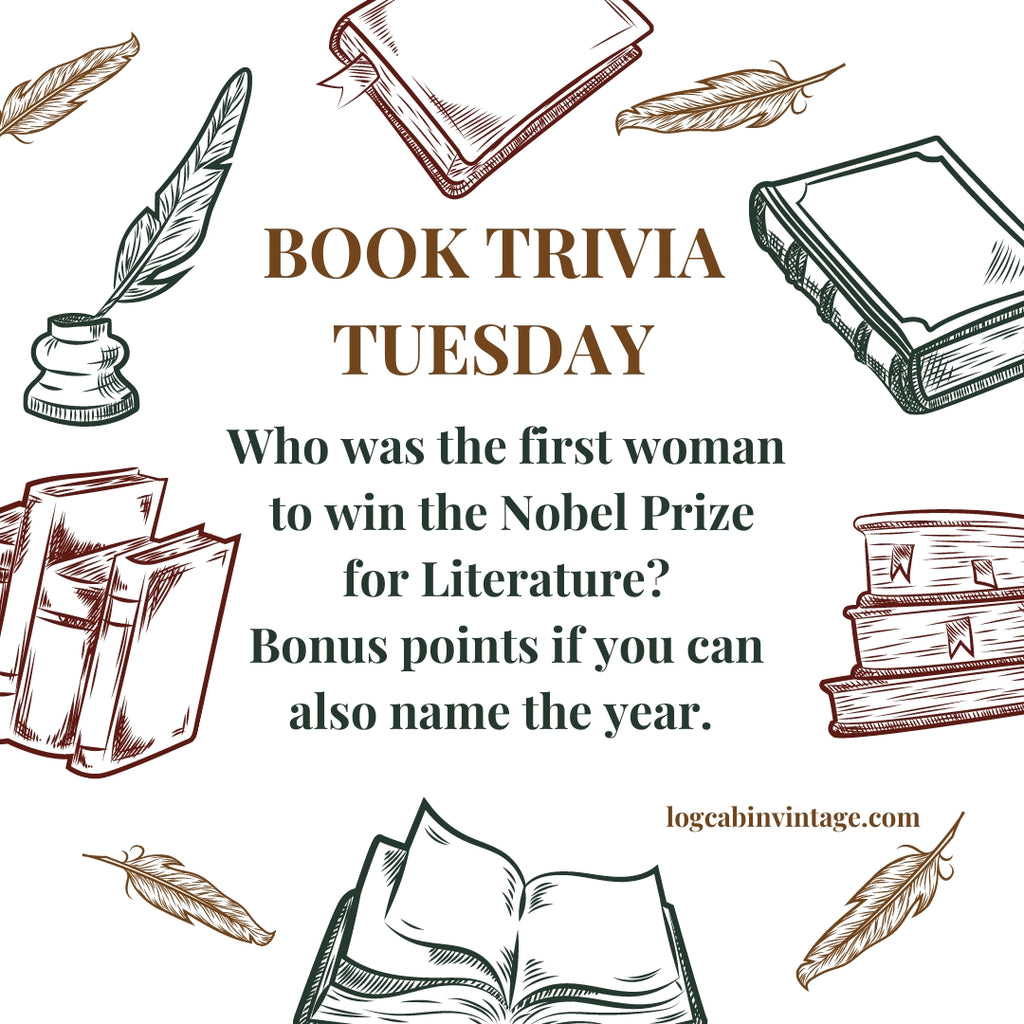
Book Trivia Week 10
Happy Tuesday! Time for another week of Book Trivia Tuesday! Last week we discussed Bemelman's Bar in NYC - where the murals of Ludwig Bemelmans (famous for his Madeline books) grace the walls of the bar.
Today's trivia question is: Who was the first woman to win the Noble Prize for Literature? Bonus Points if you can also name the year!
Selma Lagerlöf of Sweden won the Nobel Prize for Literature in 1909. She was awarded the prize in 1909 “in appreciation of the lofty idealism, vivid imagination and spiritual perception that characterize her writings.”
Her first published piece was Jerusalem which was intended to be a primer for elementary schools but actually became one of the most delightful children’s books in any language. She is best known for her work - The Wonderful Adventures of Nils which was published in 1906. You can find it here.
- 1
- 2






